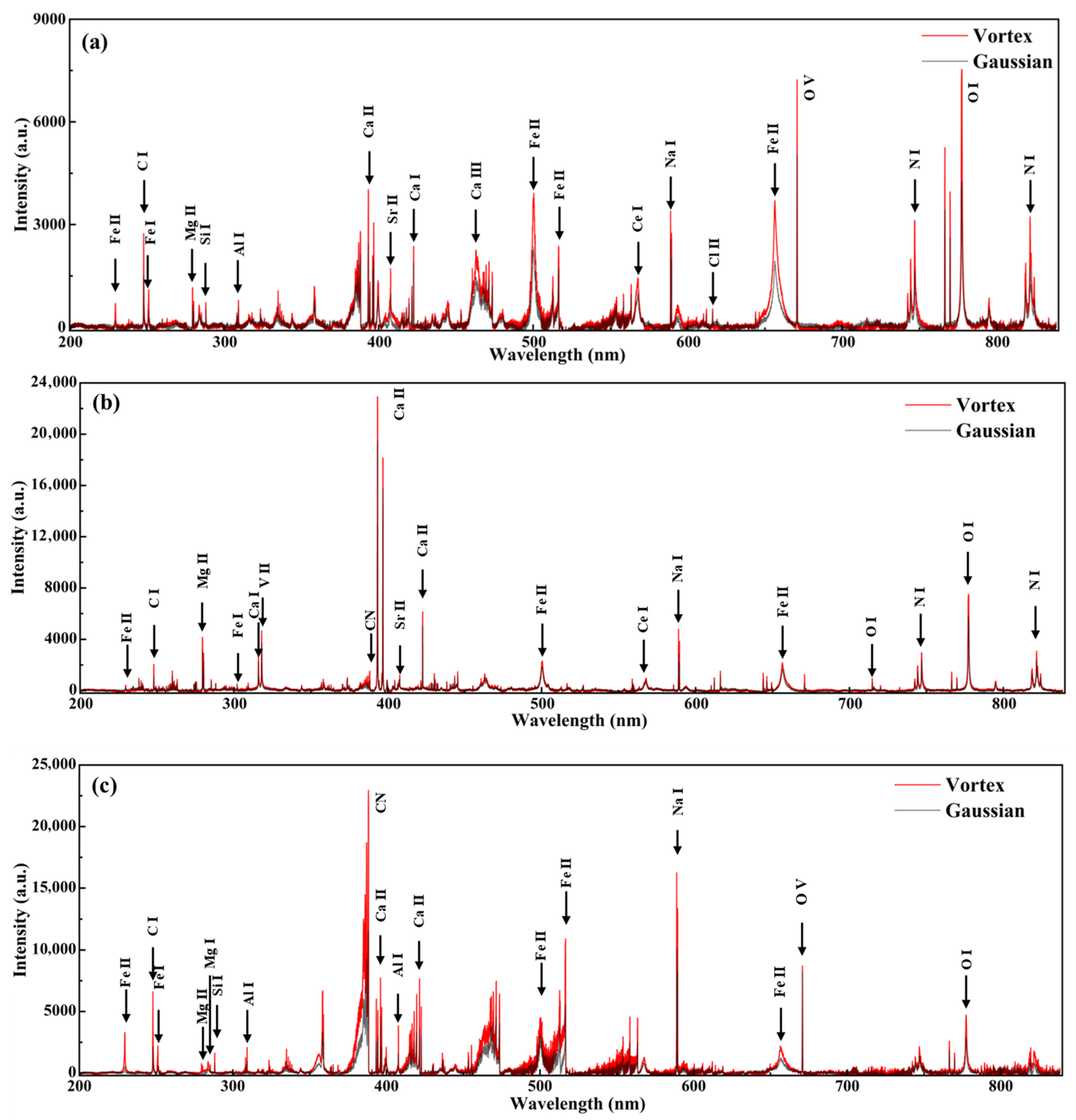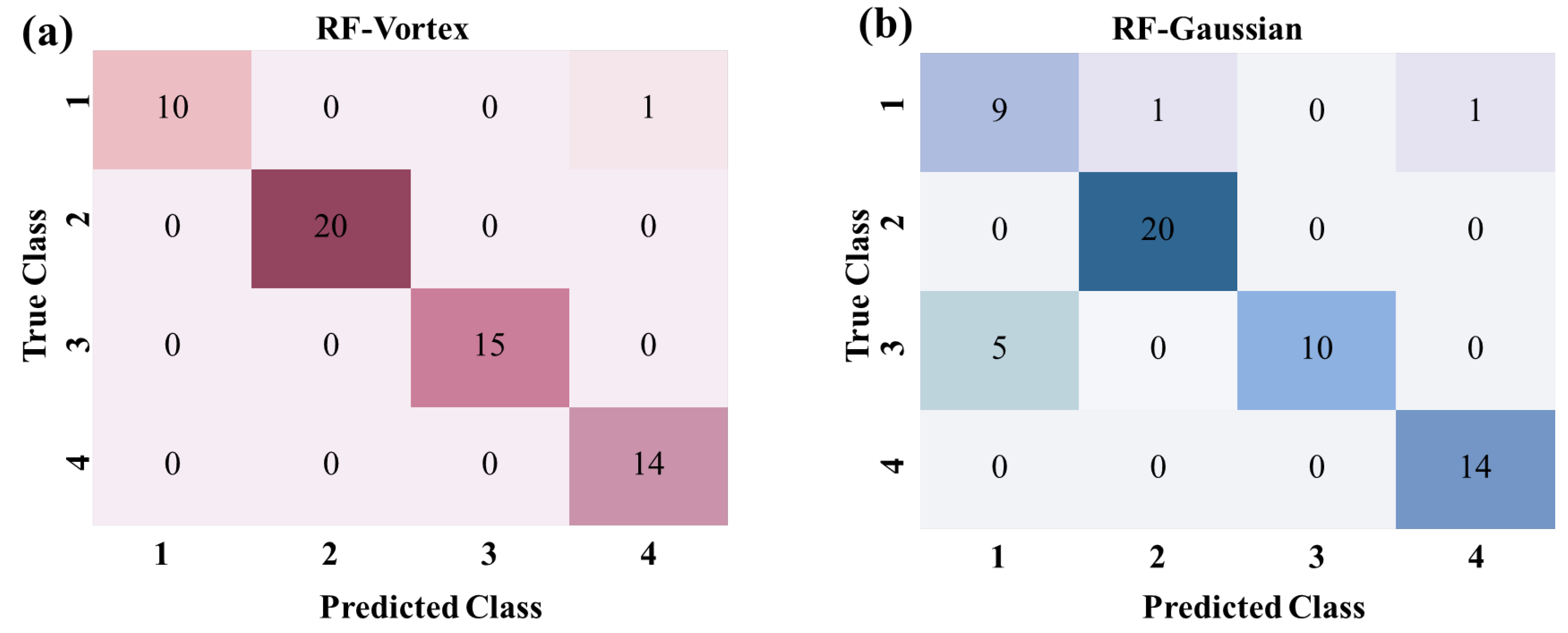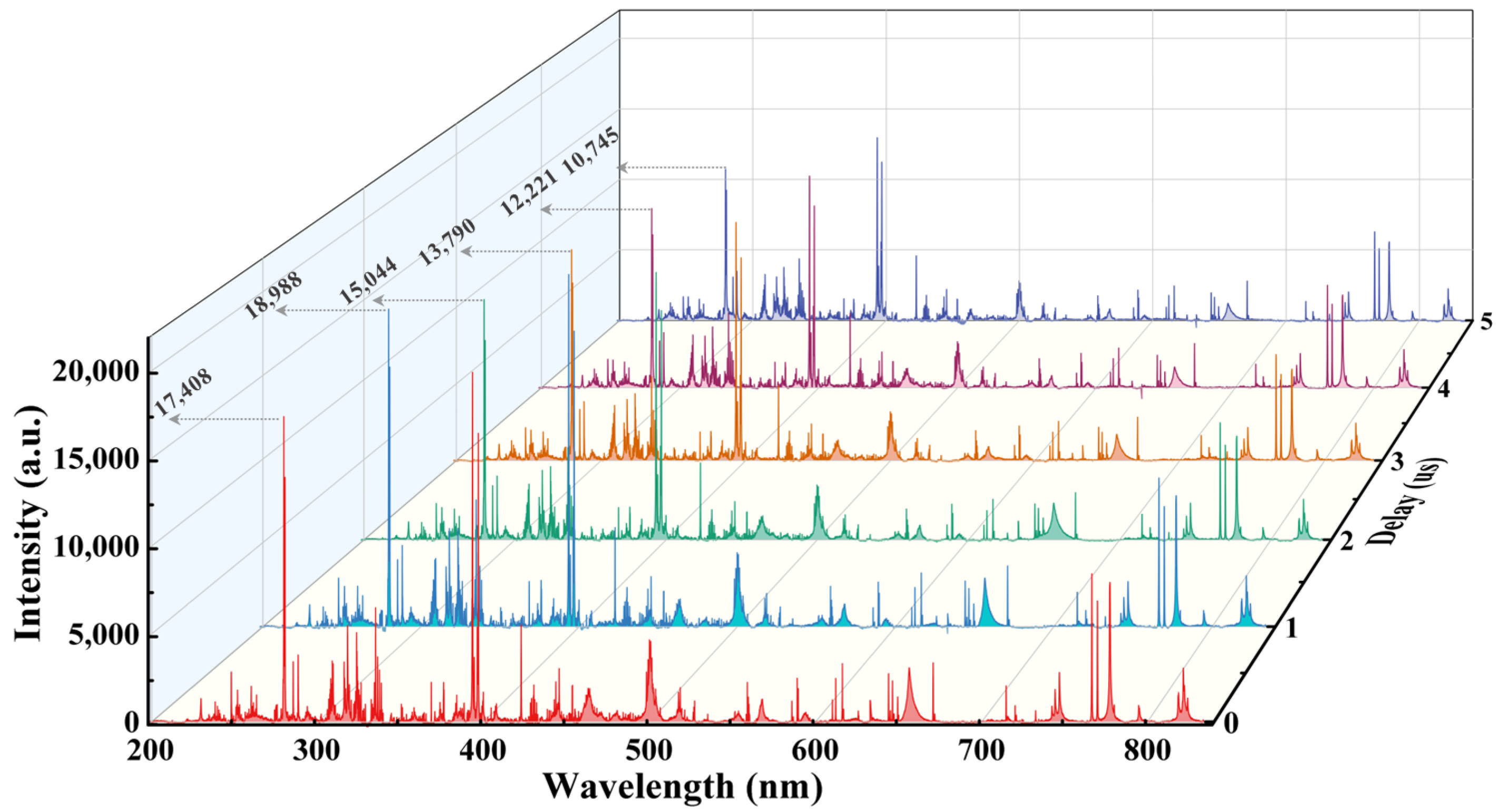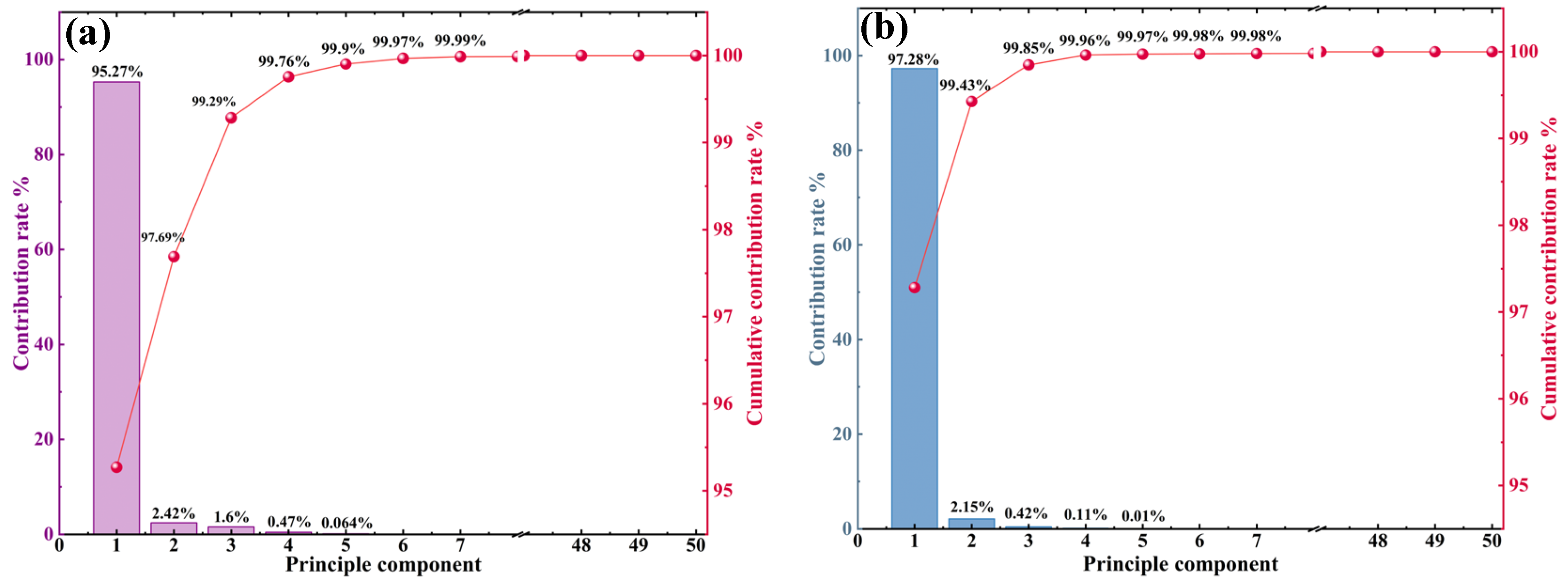Optical Vortex-Enhanced LIBS: Signal Improvement and Precise Classification of Coal Properties with Machine Learning
Abstract
1. Introduction
2. Experimental Setup
2.1. Sample Preparation
2.2. Laser-Induced Breakdown Spectroscopy Experimental Model
3. Results
3.1. Experimental Parameters Optimization
3.2. Signal Enhancement
3.3. Plasma Properties Comparison
3.4. PCA-SVM Classification
4. Conclusions
Author Contributions
Funding
Institutional Review Board Statement
Informed Consent Statement
Data Availability Statement
Conflicts of Interest
Appendix A



References
- Song, W.; Hou, Z.; Gu, W.; Afgan, M.S.; Cui, J.; Wang, H.; Wang, Y.; Wang, Z. Incorporating Domain Knowledge into Machine Learning for Laser-Induced Breakdown Spectroscopy Quantification. Spectrochim. Acta Part B At. Spectrosc. 2022, 195, 106490. [Google Scholar] [CrossRef]
- Sun, L.; Yu, H.; Cong, Z.; Lu, H.; Cao, B.; Zeng, P.; Dong, W.; Li, Y. Applications of Laser-Induced Breakdown Spectroscopy in the Aluminum Electrolysis Industry. Spectrochim. Acta Part B At. Spectrosc. 2018, 142, 29–36. [Google Scholar] [CrossRef]
- Peter, L.; Sturm, V.; Noll, R. Liquid Steel Analysis with Laser-Induced Breakdown Spectrometry in the Vacuum Ultraviolet. Appl. Spectrosc. 2003, 57, 619–624. [Google Scholar] [CrossRef]
- Fiddler, M.N.; Begashaw, I.; Mickens, M.A.; Collingwood, M.S.; Assefa, Z.; Bililign, S. Laser Spectroscopy for Atmospheric and Environmental Sensing. Sensors 2009, 9, 10447–10512. [Google Scholar] [CrossRef]
- Chen, Z.; Li, H.; Zhao, F.; Li, R. Ultra-Sensitive Trace Metal Analysis of Water by Laser-Induced Breakdown Spectroscopy after Electrical-Deposition of the Analytes on an Aluminium Surface. J. Anal. At. Spectrom. 2008, 23, 871–875. [Google Scholar] [CrossRef]
- Chu, Y.; Chen, F.; Sheng, Z.; Zhang, D.; Zhang, S.; Wang, W.; Jin, H.; Qi, J.; Guo, L. Blood Cancer Diagnosis Using Ensemble Learning Based on a Random Subspace Method in Laser-Induced Breakdown Spectroscopy. Biomed. Opt. Express 2020, 11, 4191–4202. [Google Scholar] [CrossRef]
- Wei, H.; Zhao, Z.; Lin, Q.; Duan, Y. Study on the Molecular Mechanisms against Human Breast Cancer from Insight of Elemental Distribution in Tissue Based on Laser-Induced Breakdown Spectroscopy (LIBS). Biol. Trace Elem. Res. 2021, 199, 1686–1692. [Google Scholar] [CrossRef] [PubMed]
- Guo, L.; Zhang, D.; Sun, L.; Yao, S.; Zhang, L.; Wang, Z.; Ding, H.; Lu, Y.; Hou, Z.; Wang, Z. Development in the Application of Laser-Induced Breakdown Spectroscopy in Recent Years: A Review. Front. Phys. 2021, 16, 22500. [Google Scholar] [CrossRef]
- Feng, J.; Wang, Z.; Li, Z.; Ni, W. Study to Reduce Laser-Induced Breakdown Spectroscopy Measurement Uncertainty Using Plasma Characteristic Parameters. Spectrochim. Acta Part B At. Spectrosc. 2010, 65, 549–556. [Google Scholar] [CrossRef]
- Gu, W.; Hou, Z.; Song, W.; Li, L.; Yu, X.; Liu, J.; Song, Y.; Afgan, M.S.; Li, Z.; Liu, Z.; et al. Compensation for the Variation of Total Number Density to Improve Signal Repeatability for Laser-Induced Breakdown Spectroscopy. Anal. Chim. Acta 2022, 1205, 339752. [Google Scholar] [CrossRef]
- Li, A.; Chai, S.; Peng, H.; Zhao, Z.; Ren, J.; Wu, W. Laser-Induced Breakdown Spectroscopy Using 2D Structured Light: A Case of Spectral Signal Enhancement on Metal Samples. Anal. Chem. 2025, 97, 3253–3262. [Google Scholar] [CrossRef]
- De Giacomo, A.; Dell’Aglio, M.; Bruno, D.; Gaudiuso, R.; De Pascale, O. Experimental and Theoretical Comparison of Single-Pulse and Double Pulse Laser Induced Breakdown Spectroscopy on Metallic Samples. Spectrochim. Acta Part B At. Spectrosc. 2008, 63, 805–816. [Google Scholar] [CrossRef]
- Hedwig, R.; Lie, T.; Tjia, M.; Kagawa, K.; Kurniawan, H. Confinement effect in enhancing shock wave plasma generation at low pressure by TEA CO2 laser bombardment on quartz sample. Spectrochim. Acta B At. Spectrosc. 2003, 58, 531–542. [Google Scholar] [CrossRef]
- Popov, A.M.; Colao, F.; Fantoni, R. Enhancement of LIBS Signal by Spatially Confining the Laser-Induced Plasma. J. Anal. At. Spectrom. 2009, 24, 602–604. [Google Scholar] [CrossRef]
- Ye, Z.; Ke, W.; Wang, W.; Yuan, H.; Wang, X.; Wang, X.; Liu, D.; Yang, A.; Rong, M. Enhancement by Spark Discharge in LIBS Detection of Copper Particle Contamination in Oil-Immersed Transformer. IEEE Trans. Dielectr. Electr. Insul. 2022, 29, 2034–2041. [Google Scholar] [CrossRef]
- Khan, M.; Haq, S.; Abbas, Q.; Nadeem, A. Improvement in signal sensitivity and repeatability using copper nanoparticle-enhanced laser-induced breakdown spectroscopy. Spectrochim. Acta Part B At. Spectrosc. 2022, 195, 106507. [Google Scholar] [CrossRef]
- Wu, D.; Sun, L.; Hai, R.; Liu, J.; Hao, Y.; Yu, X.; Li, C.; Feng, C.; Liu, P.; Ding, H. Influence of Transverse Magnetic Field on Plume Dynamics and Optical Emission of Nanosecond Laser Produced Tungsten Plasma in Vacuum. Spectrochim. Acta Part B At. Spectrosc. 2020, 169, 105882. [Google Scholar] [CrossRef]
- Liu, J.; Song, W.; Gu, W.; Hou, Z.; Kou, K.; Wang, Z. Long-Term Repeatability Improvement Using Beam Intensity Distribution for Laser-Induced Breakdown Spectroscopy. Anal. Chim. Acta 2023, 1251, 341004. [Google Scholar] [CrossRef]
- Jia, J.; Fu, H.; Hou, Z.; Wang, H.; Wang, Z.; Dong, F.; Ni, Z.; Zhang, Z. Effect of Laser Beam Shaping on the Determination of Manganese and Chromium Elements in Steel Samples Using Laser-Induced Breakdown Spectroscopy. Spectrochim. Acta Part B At. Spectrosc. 2020, 163, 105747. [Google Scholar] [CrossRef]
- Ji, J.; Song, W.; Hou, Z.; Li, L.; Yu, X.; Wang, Z. Raw Signal Improvement Using Beam Shaping Plasma Modulation for Uranium Detection in Ore Using Laser-Induced Breakdown Spectroscopy. Anal. Chim. Acta. 2022, 1235, 340551. [Google Scholar] [CrossRef]
- Chen, G.; Zheng, P.; Wang, J.; Li, B.; Liu, X.; Yang, Z.; Sun, Z.; Tian, H.; Dong, D.; Guo, L. Quantitative Analysis Improvement of Laser-Induced Breakdown Spectroscopy Based a Newly Beam Shaping Method. Talanta 2025, 292, 127993. [Google Scholar] [CrossRef]
- Yan, W.; Lv, J.; Zhu, C.; Li, Q.; Chen, J.; Kang, L.; Lu, B.; Li, X. Classification of Uneven Steel Samples by Laser-Induced Breakdown Spectroscopy Based on a Bessel Beam. J. Anal. At. Spectrom. 2023, 38, 1232–1237. [Google Scholar] [CrossRef]
- Hai, R.; Sun, L.; Wu, D.; He, Z.; Sattar, H.; Liu, J.; Tong, W.; Li, C.; Feng, C.; Ding, H. Enhanced Laser-Induced Breakdown Spectroscopy Using the Combination of Circular and Annular Laser Pulses. J. Anal. At. Spectrom. 2019, 34, 1982–1987. [Google Scholar] [CrossRef]
- Delaney, B.; Hayden, P.; Kelly, T.; Kennedy, E.; Costello, J. Laser Induced Breakdown Spectroscopy with Annular Plasmas in Vacuo: Stagnation and Limits of Detection. Spectrochim. Acta Part B At. Spectrosc. 2022, 193, 106430. [Google Scholar] [CrossRef]
- Allen, L.; Beijersbergen, M.W.; Spreeuw, R.; Woerdman, J. Orbital Angular Momentum of Light and the Transformation of Laguerre-Gaussian Laser Modes. Phys. Rev. A 1992, 45, 8185–8189. [Google Scholar] [CrossRef]
- Yao, A.M.; Padgett, M.J. Orbital Angular Momentum: Origins, Behavior and Applications. Adv. Opt. Photonics 2011, 3, 161–204. [Google Scholar] [CrossRef]
- Fang, J.; Li, J.; Kong, A.; Xie, Y.; Lin, C.; Xie, Z.; Lei, T.; Yuan, X. Optical Orbital Angular Momentum Multiplexing Communication via Inversely Designed Multiphase Plane Light Conversion. Photonics Res. 2022, 10, 2015–2023. [Google Scholar] [CrossRef]
- Ng, J.; Lin, Z.; Chan, C. Theory of Optical Trapping by an Optical Vortex Beam. Phys. Rev. Lett. 2010, 104, 103601. [Google Scholar] [CrossRef]
- Omatsu, T.; Miyamoto, K.; Toyoda, K.; Morita, R.; Arita, Y.; Dholakia, K. Twisted Materials: A New Twist for Materials Science: The Formation of Chiral Structures Using the Angular Momentum of Light. Adv. Opt. Mater. 2019, 7, 1970052. [Google Scholar] [CrossRef]
- Ni, J.; Wang, C.; Zhang, C.; Hu, Y.; Yang, L.; Lao, Z.; Xu, B.; Li, J.; Wu, D.; Chu, J. Three-Dimensional Chiral Microstructures Fabricated by Structured Optical Vortices in Isotropic Material. Light Sci. Appl. 2017, 6, e17011. [Google Scholar] [CrossRef]
- Bretschneider, S.; Eggeling, C.; Hell, S.W. Breaking the Diffraction Barrier in Fluorescence Microscopy by Optical Shelving. Phys. Rev. Lett. 2007, 98, 218103. [Google Scholar] [CrossRef]
- Shen, Y.; Wang, X.; Xie, Z.; Min, C.; Fu, X.; Liu, Q.; Gong, M.; Yuan, X. Optical Vortices 30 Years on: OAM Manipulation from Topological Charge to Multiple Singularities. Light Sci. Appl. 2019, 8, 90. [Google Scholar] [CrossRef] [PubMed]
- Wang, Q.; Dang, W.; Jiang, Y.; Chen, A.; Jin, M. Emission Enhancement of Femtosecond Laser-Induced Breakdown Spectroscopy Using Vortex Beam. J. Phys. B At. Mol. Opt. Phys. 2022, 55, 095402. [Google Scholar] [CrossRef]
- Bao, M.; Zhao, Z.; Wei, K.; Zheng, Y.; Lu, B.; Xu, X.; Luo, T.; Teng, G.; Yong, J.; Wang, Q. Modulate the Laser Phase to Improve the ns-LIBS Spectrum Signal Based on Orbital Angular Momentum. Opt. Express 2024, 32, 4998–5010. [Google Scholar] [CrossRef] [PubMed]
- Fu, Y.; Lin, C.; Sun, D.; Han, W.; Chang, J.; Ma, X.; Su, M. Effect of Vortex Beam Shaping on Determination of Trace Elements in Al Alloy by Double Pulse Laser-Induced Breakdown Spectroscopy. Plasma Sci. Technol. 2025, 27, 095503. [Google Scholar] [CrossRef]
- Vieira, J.; Mendonca, J. Nonlinear Laser Driven Donut Wake Fields for Positron and Electron Acceleration. Phys. Rev. Lett. 2014, 112, 215001. [Google Scholar] [CrossRef]
- Brabetz, C.; Eisenbarth, U.; Kester, O.; Stoehlker, T.; Cowan, T.; Zielbauer, B.; Bagnoud, V. Hollow Beam Creation with Continuous Diffractive Phase Mask at PHELIX. In CLEO: Science and Innovations; Optica Publishing Group: Washington, DC, USA, 2012; p. JTu1K.5. [Google Scholar] [CrossRef]
- Busold, S.; Almomani, A.; Bagnoud, V.; Barth, W.; Bedacht, S.; Blažević, A.; Boine-Frankenheim, O.; Brabetz, C.; Burris-Mog, T.; Cowan, T.; et al. Shaping Laser Accelerated Ions for Future Applications—The LIGHT Collaboration. Nucl. Instrum. Methods Phys. Res. A 2014, 740, 94–98. [Google Scholar] [CrossRef]
- Shi, Y.; Zhang, X.; Arefiev, A.; Shen, B. Advances in Laser-Plasma Interactions Using Intense Vortex Laser Beams. Sci. China Phys. Mech. Astron. 2024, 67, 295201. [Google Scholar] [CrossRef]
- GB/T 212-2008; Proximate Analysis of Coal. Standardization Administration of People’s Republic of China: Beijing, China, 2008.
- GB/T 213-2008; Determination of Calorific Value of Coal. Standardization Administration of People’s Republic of China: Beijing, China, 2008.
- Wang, W.; Dong, H.; Shi, Z.; Leng, Y.; Li, R.; Xu, Z. Collimated Particle Acceleration by Vortex Laser-Induced Self-Structured “Plasma Lens”. Appl. Phys. Lett. 2022, 121, 211101. [Google Scholar] [CrossRef]
- Cristoforetti, G.; De Giacomo, A.; Dell’Aglio, M.; Legnaioli, S.; Tognoni, E.; Palleschi, V.; Omenetto, N. Local Thermodynamic Equilibrium in Laser Induced Breakdown Spectroscopy: Beyond the McWhirter Criterion. Spectrochim. Acta Part B At. Spectrosc. 2010, 65, 86–95. [Google Scholar] [CrossRef]









| Coal Sample | Moisture/% | Volatiles/% | Ash/% | St/% | Calorific Value (cal/g) | Fixed Carbon/% |
|---|---|---|---|---|---|---|
| Lignite | 5.3 | 38.8 | 24.1 | 0.02 | 4483 | 31.8 |
| High-Sulfur Coal | 1.5 | 8.3 | 27.1 | 4.98 | 2485 | 63.4 |
| Anthracite | 0.6 | 6.5 | 10.9 | 0.37 | 7245 | 82 |
| Long Flame Coal | 3.5 | 31.7 | 3 | 0.15 | 7262 | 61.8 |
| Ion | Wavelength (nm) | Aki (108 s−1) | gk | Ek (eV) |
|---|---|---|---|---|
| Ca II | 315.89 | 3.1 | 4 | 7.05 |
| Ca II | 317.93 | 3.6 | 6 | 7.05 |
| Ca II | 373.69 | 1.7 | 2 | 6.47 |
| Ca II | 393.37 | 1.47 | 4 | 3.15 |
| Ca II | 396.85 | 1.4 | 2 | 3.12 |
| Model | Light Source | Metric | Type 1 | Type 2 | Type 3 | Type 4 | Average | Test Accuracy (Mean ± Std, %) |
|---|---|---|---|---|---|---|---|---|
| PCA-SVM | Vortex | Precision | 0.92 | 1.00 | 1.00 | 0.87 | 0.95 | 94.42 ± 2.82 |
| Recall | 1.00 | 0.9 | 1.00 | 0.93 | 0.96 | |||
| F1-Score | 0.96 | 0.95 | 1.00 | 0.9 | 0.95 | |||
| Gaussian | Precision | 0.61 | 1.00 | 1.00 | 1.00 | 0.90 | 86.67 ± 8.13 | |
| Recall | 1.00 | 1.00 | 0.53 | 1.00 | 0.88 | |||
| F1-Score | 0.76 | 1.00 | 0.70 | 1.00 | 0.87 | |||
| RF | Vortex | Precision | 1.00 | 1.00 | 1.00 | 0.93 | 0.98 | 94.00 ± 2.56 |
| Recall | 0.91 | 1.00 | 1.00 | 1.00 | 0.98 | |||
| F1-Score | 0.95 | 1.00 | 1.00 | 0.97 | 0.98 | |||
| Gaussian | Precision | 0.64 | 0.95 | 1.00 | 0.93 | 0.88 | 91.33 ± 3.65 | |
| Recall | 0.82 | 1.00 | 1.00 | 0.67 | 0.87 | |||
| F1-Score | 0.72 | 0.98 | 0.80 | 0.97 | 0.87 |
Disclaimer/Publisher’s Note: The statements, opinions and data contained in all publications are solely those of the individual author(s) and contributor(s) and not of MDPI and/or the editor(s). MDPI and/or the editor(s) disclaim responsibility for any injury to people or property resulting from any ideas, methods, instructions or products referred to in the content. |
© 2025 by the authors. Licensee MDPI, Basel, Switzerland. This article is an open access article distributed under the terms and conditions of the Creative Commons Attribution (CC BY) license (https://creativecommons.org/licenses/by/4.0/).
Share and Cite
Zhou, Y.; Yasen, A.; Ye, J.; Aierken, P.; Abulimiti, B.; Xiang, M. Optical Vortex-Enhanced LIBS: Signal Improvement and Precise Classification of Coal Properties with Machine Learning. Appl. Sci. 2025, 15, 11590. https://doi.org/10.3390/app152111590
Zhou Y, Yasen A, Ye J, Aierken P, Abulimiti B, Xiang M. Optical Vortex-Enhanced LIBS: Signal Improvement and Precise Classification of Coal Properties with Machine Learning. Applied Sciences. 2025; 15(21):11590. https://doi.org/10.3390/app152111590
Chicago/Turabian StyleZhou, Yuxia, Abulimiti Yasen, Jianqiang Ye, Palidan Aierken, Bumaliya Abulimiti, and Mei Xiang. 2025. "Optical Vortex-Enhanced LIBS: Signal Improvement and Precise Classification of Coal Properties with Machine Learning" Applied Sciences 15, no. 21: 11590. https://doi.org/10.3390/app152111590
APA StyleZhou, Y., Yasen, A., Ye, J., Aierken, P., Abulimiti, B., & Xiang, M. (2025). Optical Vortex-Enhanced LIBS: Signal Improvement and Precise Classification of Coal Properties with Machine Learning. Applied Sciences, 15(21), 11590. https://doi.org/10.3390/app152111590






